Three-Component Suzuki–Knoevenagel Synthesis of Merocyanine Libraries and Correlation Analyses of Their Oxidation Potentials and Optical Band Gaps
Abstract
:1. Introduction
2. Results and Discussion
2.1. Synthesis
2.2. Electronic Characteristics
2.3. Correlation Analyses of the Electronic Properties
3. Materials and Methods
Synthesis of Compound 9d by Coupling-Condensation One-Pot Synthesis (Typical Procedure)
4. Conclusions
Supplementary Materials
Author Contributions
Funding
Institutional Review Board Statement
Informed Consent Statement
Data Availability Statement
Acknowledgments
Conflicts of Interest
Sample Availability
References
- Zhu, J.; Wang, Q.; Wang, M.-X. Multi-Component Reactions in Organic Synthesis; Wiley-VHC: Weinheim, Germany, 2015. [Google Scholar] [CrossRef]
- Müller, T.J.J. Science of Synthesis Series: Multicomponent Reactions 1 – General Discussion and Reactions Involving a Carbonyl Compound as Electrophilic Component; Müller, T.J.J., Ed.; Georg Thieme: Stuttgart, Germany, 2014; pp. 5–27. [Google Scholar] [CrossRef]
- D’Souza, D.M.; Müller, T.J.J. Multi-Component Syntheses of Heterocycles by Transition Metal Catalysis. Chem. Soc. Rev. 2007, 36, 1095–1108. [Google Scholar] [CrossRef]
- Dömling, A.; Ugi, I. Multicomponent Reactions with Isocyanides. Angew. Chem. Int. Ed. 2000, 39, 3169–3210. [Google Scholar] [CrossRef]
- Levi, L.; Müller, T.J.J. Multicomponent syntheses of functional chromophores. Chem. Soc. Rev. 2016, 45, 2825–2846. [Google Scholar] [CrossRef] [Green Version]
- Müller, T.J.J.; Bunz, U.H.F. Functional Organic Materials; Wiley-VHC: Weinheim, Germany, 2007. [Google Scholar] [CrossRef]
- Levi, L.; Müller, T.J.J. Multicomponent Syntheses of Fluorophores Initiated by Metal Catalysis. Eur. J. Org. Chem. 2016, 2907–2918. [Google Scholar] [CrossRef]
- Shindy, H.A. Fundamentals in the chemistry of cyanine dyes: A review. Dyes Pigm. 2017, 145, 505–513. [Google Scholar] [CrossRef]
- Panigrahi, M.; Dash, S.; Patel, S.; Mishra, B.K. Syntheses of Cyanines: A Review. Tetrahedron 2012, 68, 781–805. [Google Scholar] [CrossRef]
- Kulinich, A.V.; Ishchenko, A.A. Merocyanine dyes: Synthesis, structure, properties and applications. Russ. Chem. Rev. 2009, 78, 141–164. [Google Scholar] [CrossRef]
- Shirinian, V.Z.; Shimkim, A.A. Merocyanines: Synthesis and Application. Top. Heterocycl. Chem. 2008, 14, 75–105. [Google Scholar] [CrossRef]
- Mishra, A.; Behera, R.K.; Behera, P.K.; Mishra, B.K.; Behera, G.B. Cyanines during the 1990s: A Review. Chem. Rev. 2000, 100, 1973–2011. [Google Scholar] [CrossRef]
- Hamer, F.M. The Cyanine Dyes and Related Compounds. Available online: https://onlinelibrary.wiley.com/doi/book/10.1002/9780470186794 (accessed on 16 July 2021).
- Kim, T.-D.; Lee, K.-S. D-π-A Conjugated Molecules for Optoelectronic Applications. Macromol. Rapid Commun. 2015, 36, 943–958. [Google Scholar] [CrossRef] [PubMed]
- Castet, F.; Rodriguez, V.; Pozzo, J.-L.; Ducasse, L.; Plaquet, A.; Champagne, B. Design and Characterization of Molecular Nonlinear Optical Switches. Acc. Chem. Res. 2013, 46, 2656–2665. [Google Scholar] [CrossRef] [PubMed]
- Marder, S.R. Organic nonlinear optical materials: Where we have been and where we are going. Chem. Commun. 2006, 131–134. [Google Scholar] [CrossRef]
- Würthner, F.; Wortmann, R.; Meerholz, K. Chromophore design for photorefractive organic materials. ChemPhysChem 2002, 3, 17–31. [Google Scholar] [CrossRef]
- Gsänger, M.; Bialas, D.; Huang, L.; Stolte, M.; Würthner, F. Organic Semiconductors based on Dyes and Color Pigments. Adv. Mater. 2016, 28, 3615–3645. [Google Scholar] [CrossRef] [PubMed]
- Leo, K. Elementary Processes in Organic Photovoltaics; Springer: Cham, Switzerland, 2017; pp. 193–214. [Google Scholar] [CrossRef]
- Würthner, F. Dipole–Dipole Interaction Driven Self-Assembly of Merocyanine Dyes: From Dimers to Nanoscale Objects and Supramolecular Materials. Acc. Chem. Res. 2016, 49, 868–876. [Google Scholar] [CrossRef] [PubMed]
- Heyne, B. Self-assembly of organic dyes in supramolecular aggregates. Photochem. Photobiol. Sci. 2016, 15, 1103–1114. [Google Scholar] [CrossRef]
- Kovtun, Y.P.; Prostota, Y.O.; Shandura, M.P.; Poronik, Y.M.; Tolmachev, A.I. Metallochromic merocyanines of 8-hydroxyquinoline series. II. Dyes with end nuclei of low basicity. Dyes Pigm. 2004, 60, 215–221. [Google Scholar] [CrossRef]
- Kovtun, Y.P.; Prostota, Y.O.; Tolmachev, A.I. Metallochromic merocyanines of 8-hydroxyquinoline series. Dyes Pigm. 2003, 58, 83–91. [Google Scholar] [CrossRef]
- Yagi, S.; Maeda, K.; Nakazumi, H.J. Photochromic properties of cationic merocyanine dyes. Thermal stability of the spiropyran form produced by irradiation with visible light. Mater. Chem. 1999, 9, 2991–2997. [Google Scholar] [CrossRef]
- Elsner, A.-L.; Biesen, L.; Müller, T.J.J. Pseudo-Five-component Synthesis of Indolone-3-aminopropenylidene Merocyanine Dimers and Their Attenuated Aggregation-Induced Emission. ARKIVOC 2021, 53–66. [Google Scholar] [CrossRef]
- D’Souza, D.M.; Muschelknautz, C.; Rominger, F.; Müller, T.J.J. Unusual Solid-State Luminescent Push-Pull Indolones: A general One-Pot Three-component Approach. Org. Lett. 2010, 12, 3364–3367. [Google Scholar] [CrossRef]
- Denißen, M.; Hannen, R.; Itskalov, D.; Biesen, L.; Nirmalananthan-Budau, N.; Hoffmann, K.; Reiss, G.J.; Resch-Genger, U.; Müller, T.J.J. One-pot Synthesis of a White-light Emissive Bichromophore Operated by Aggregation-induced Dual Emission (AIDE) and Partial Energy Transfer. Chem. Commun. 2020, 56, 7407–7410. [Google Scholar] [CrossRef] [PubMed]
- Pasch, P.; Papadopoulos, J.; Goralczyk, A.; Hofer, M.L.; Tabatabai, M.; Müller, T.J.J.; Hartmann, L. Highly fluorescent merocyanine and cyanine PMMA copolymers. Macromol. Rapid Commun. 2018, 39, 1800277. [Google Scholar] [CrossRef] [PubMed]
- Muschelknautz, C.; Frank, W.; Müller, T.J.J. Rapid Access to Unusual Solid-State Luminescent Merocyanines by a Novel One-Pot Three-component Synthesis. Org. Lett. 2011, 13, 2556–2559. [Google Scholar] [CrossRef]
- Papadopoulos, J.; Merkens, K.; Müller, T.J.J. Three-Component Synthesis and Photophysical Properties of Novel Coumarin-based Merocyanines. Chem. Eur. J. 2018, 24, 974–983. [Google Scholar] [CrossRef] [PubMed]
- Meyer, T.; Müller, T.J.J. Consecutive Three-Component Synthesis of Donor-Substituted Merocyanines by One-pot Suzuki-Knoevenagel Condensation (SuKnoCon) Sequence. Org. Mater. 2020, 2, 64–70. [Google Scholar] [CrossRef] [Green Version]
- Park, S.Y.; Park, G.E.; Choi, S.; Lee, J.H.; Lee, D.H.; Cho, M.J.; Choi, D.H. Effect of acceptor strength in new acceptor-donor-acceptor-type molecules on their miscibility with donor polymers for bulk-heterojunction fullerene-free solar cells. Dyes Pigm. 2017, 146, 226–233. [Google Scholar] [CrossRef]
- Hedström, S.; Wang, E.; Persson, P. Defining donor and acceptor strength in conjugated copolymers. Mol. Phys. 2017, 115, 485–496. [Google Scholar] [CrossRef]
- Zanello, P. Electrochemical and X-ray Structural Aspects of Transition Metal Complexes Containing Redox-Active Ferrocene Ligands in Ferrocenes; Togni, A., Hayashi, T., Eds.; Wiley VHC: Weinheim, Germany, 1995; p. 317. [Google Scholar] [CrossRef]

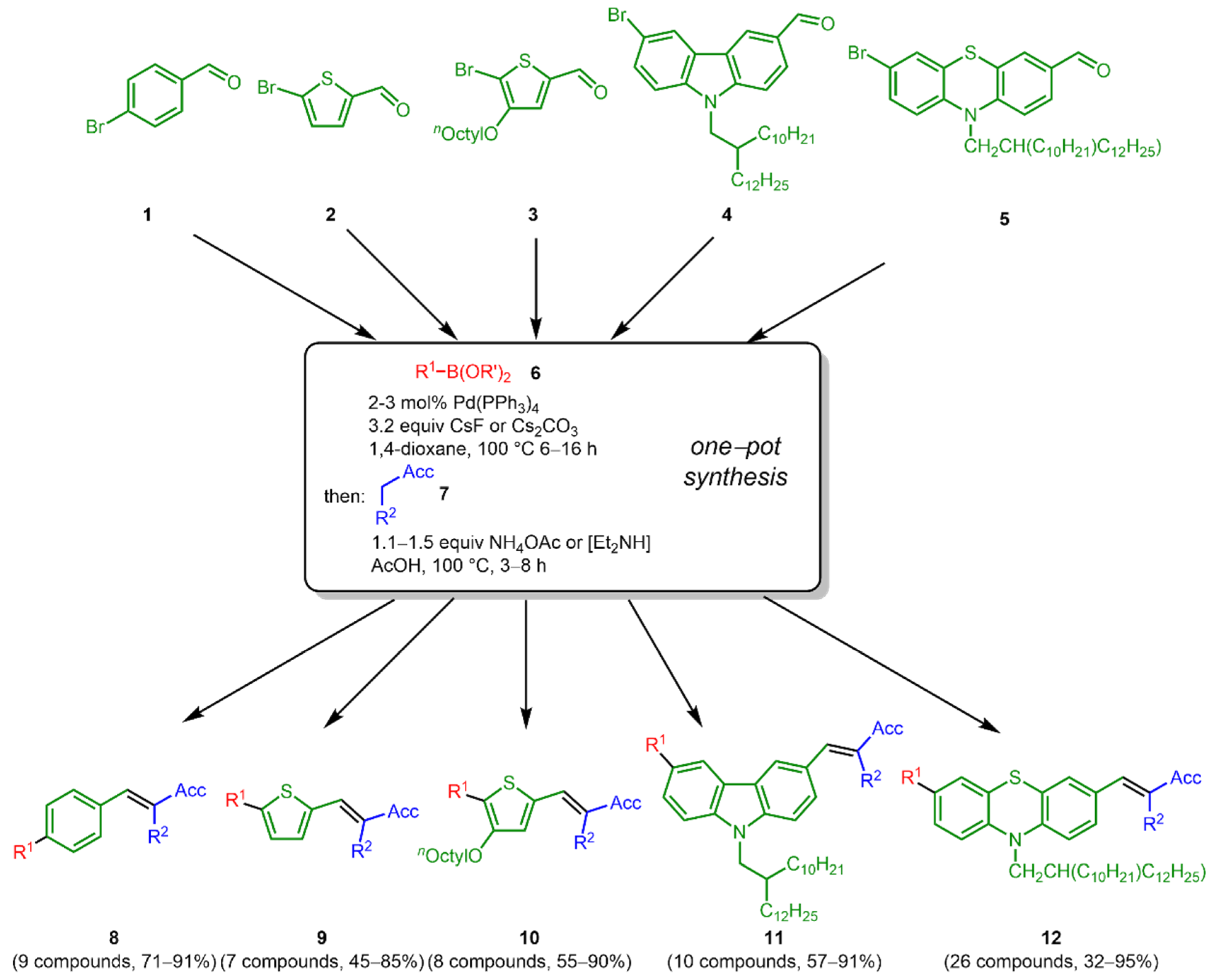
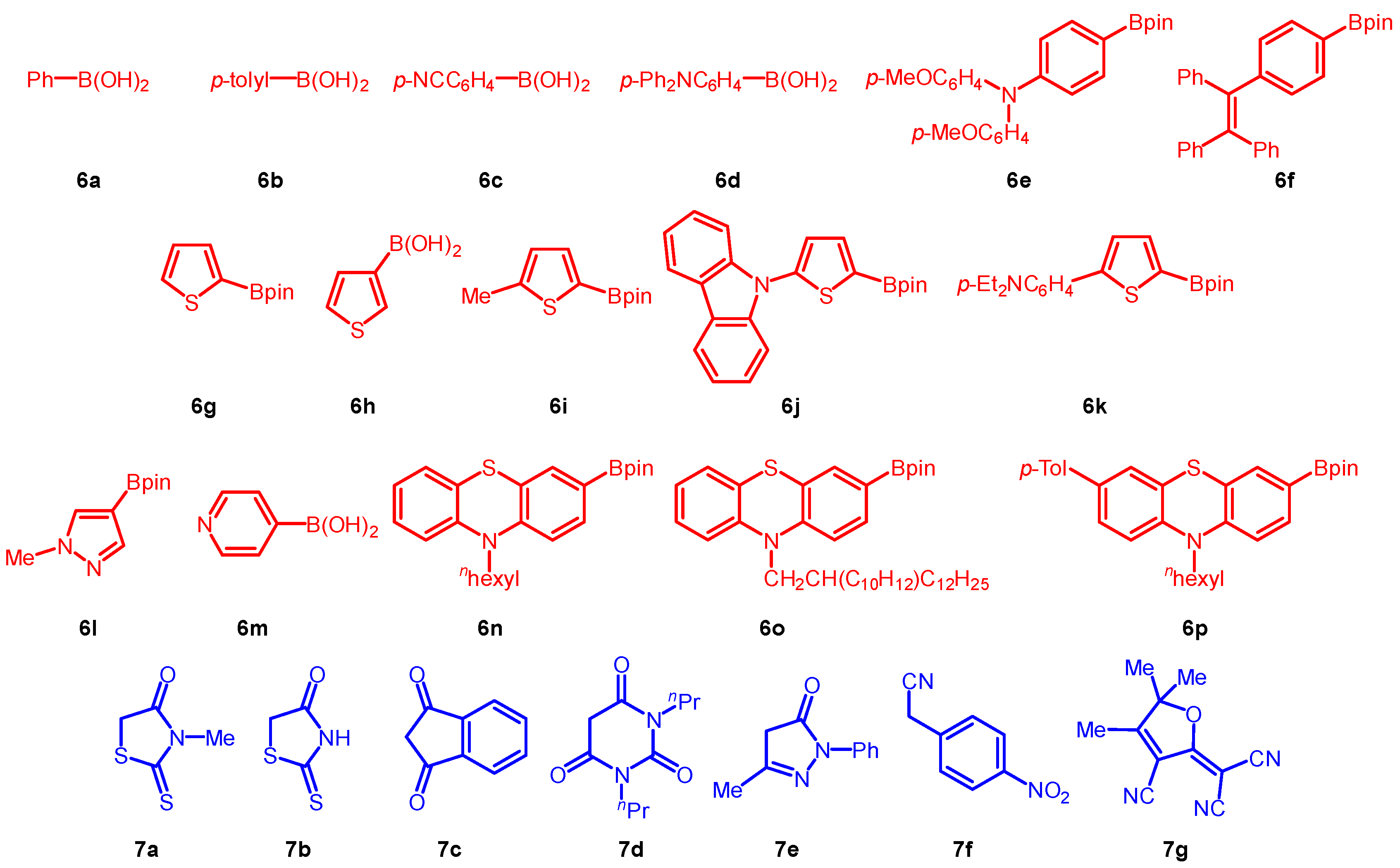



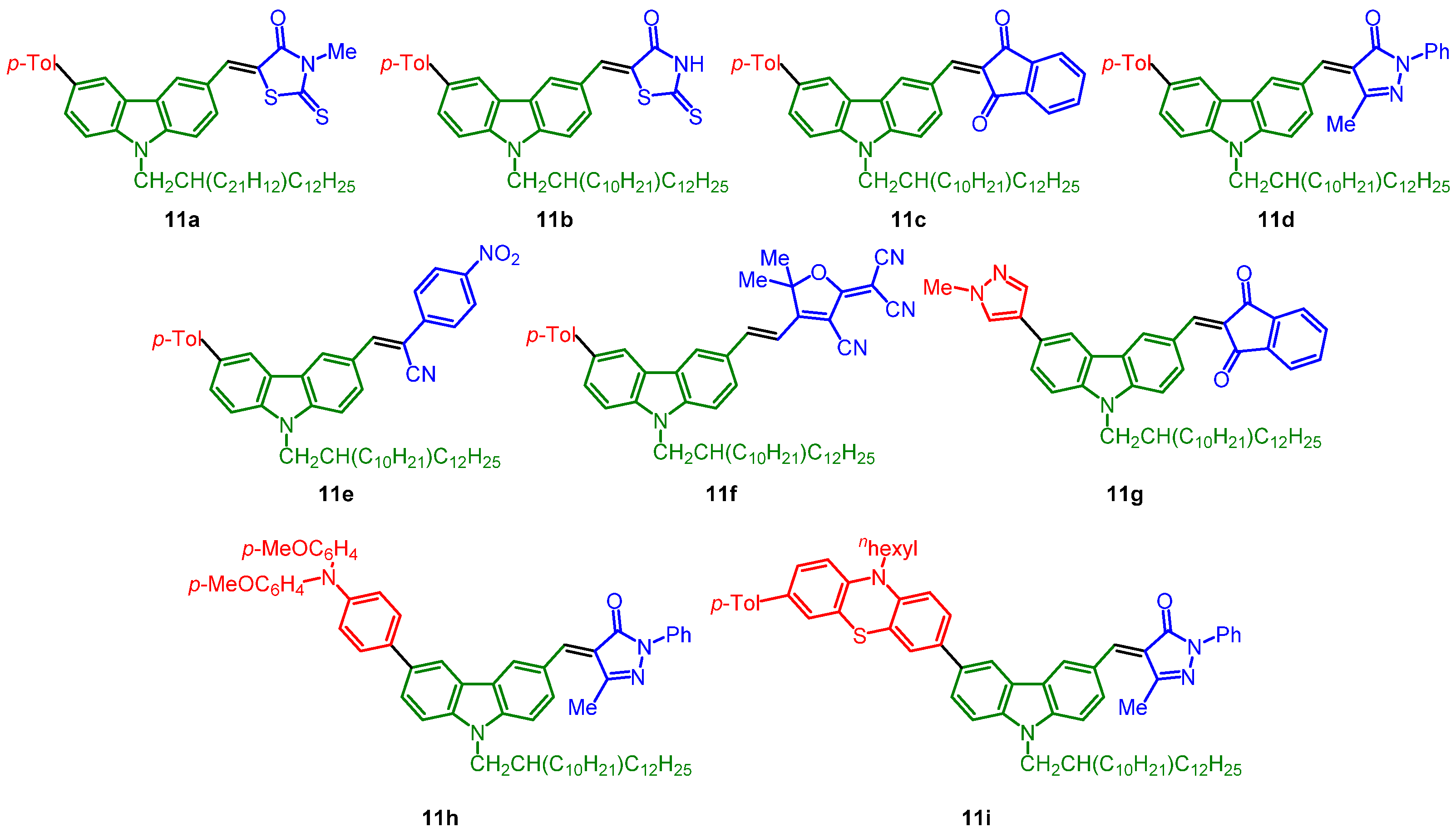
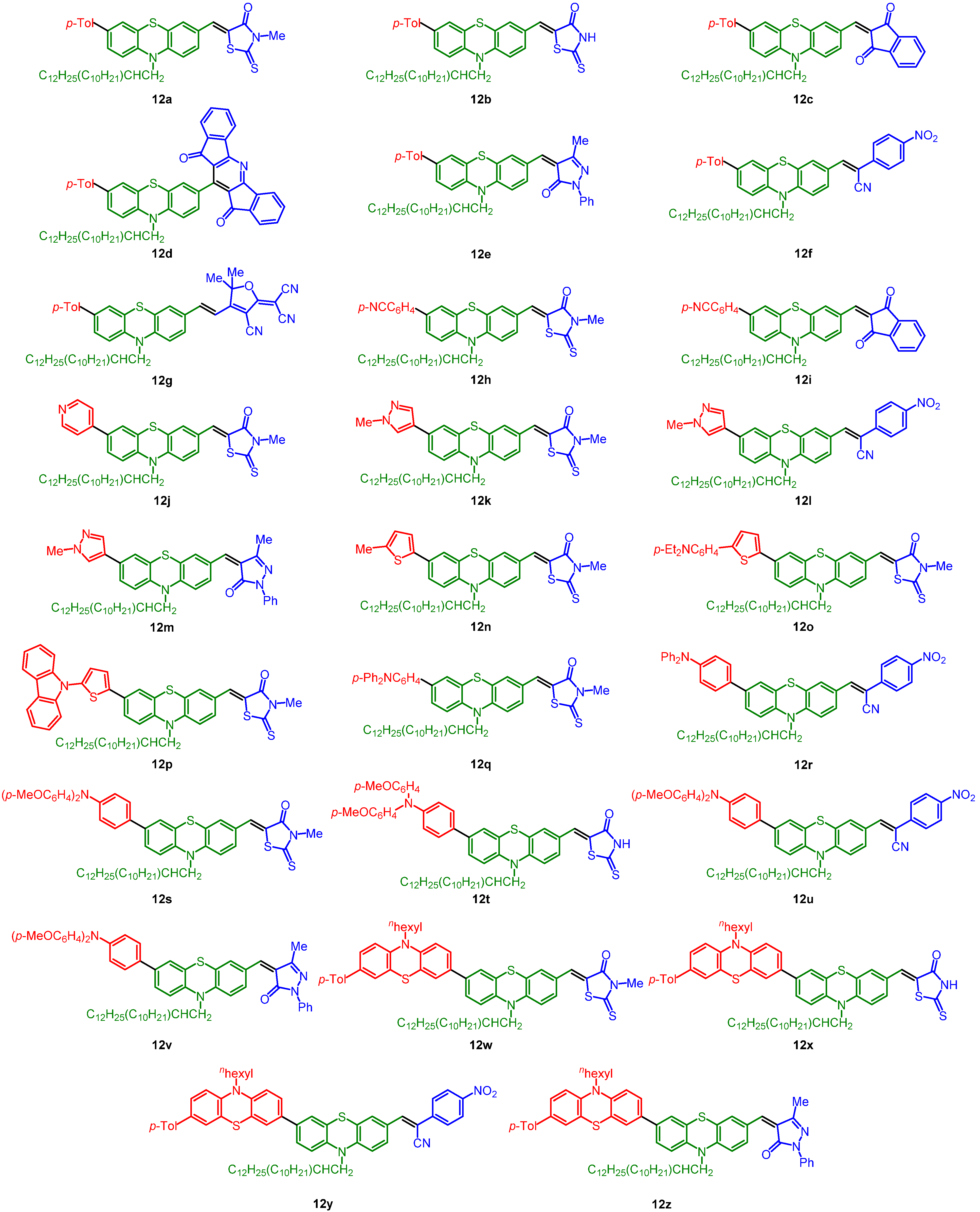
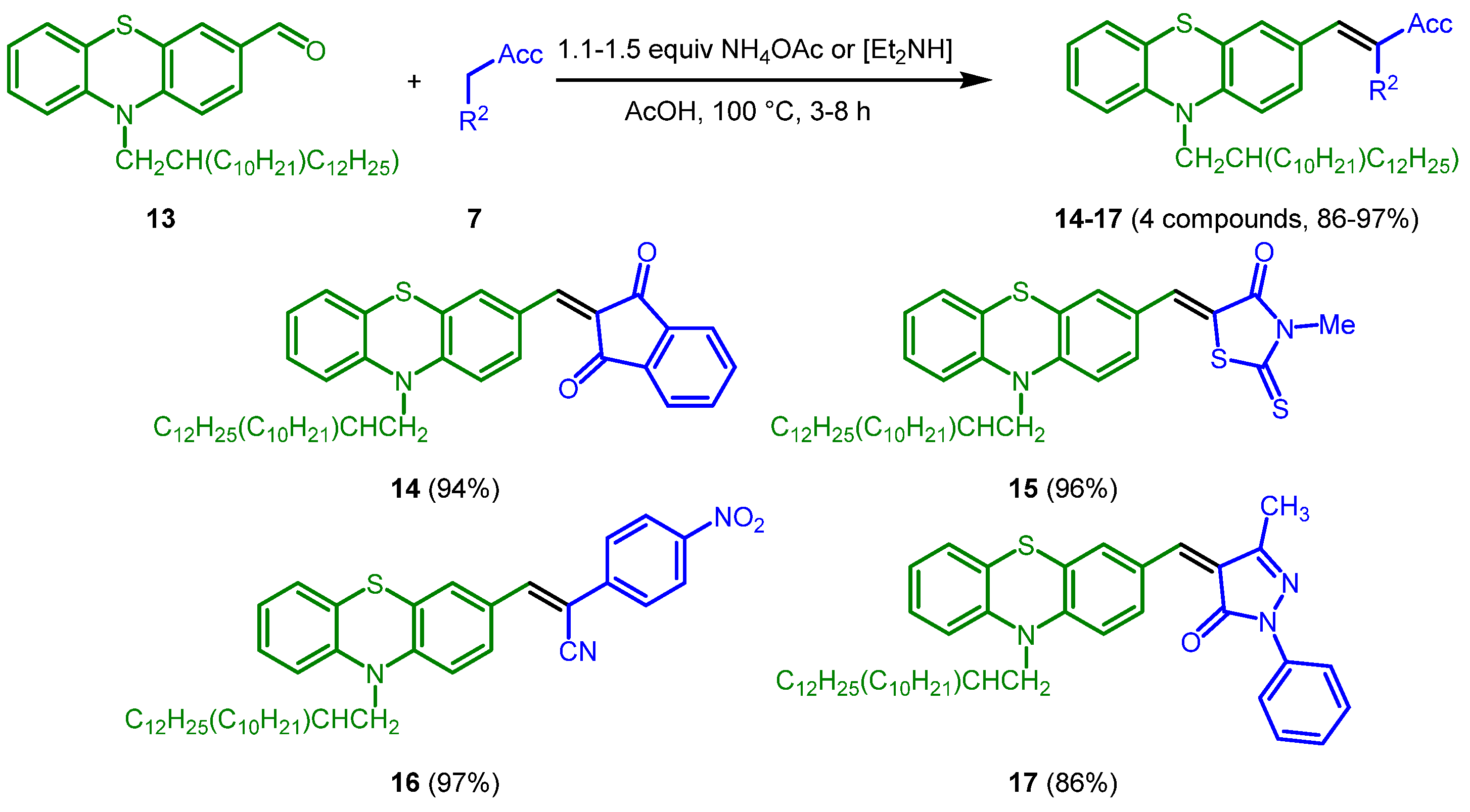
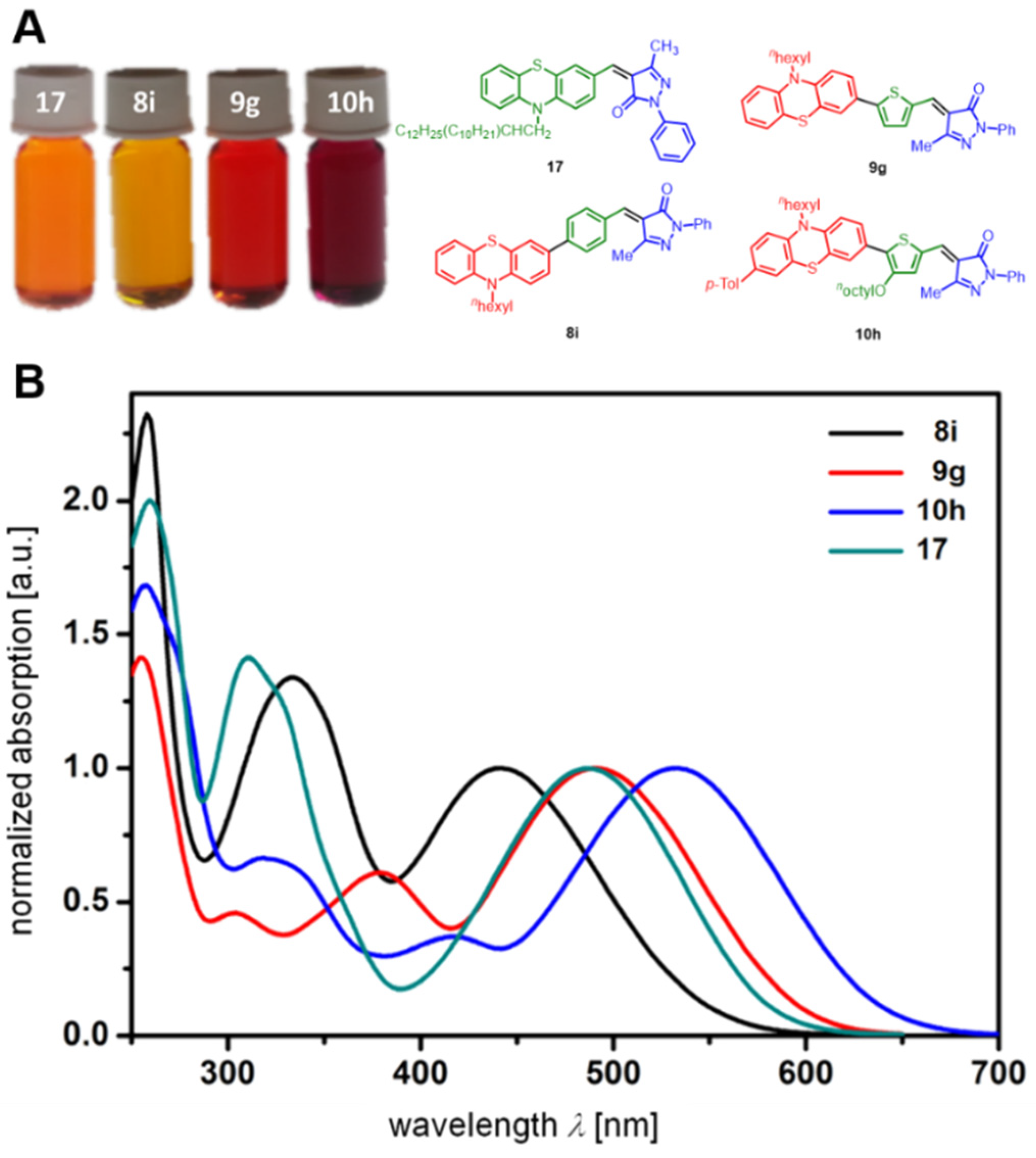
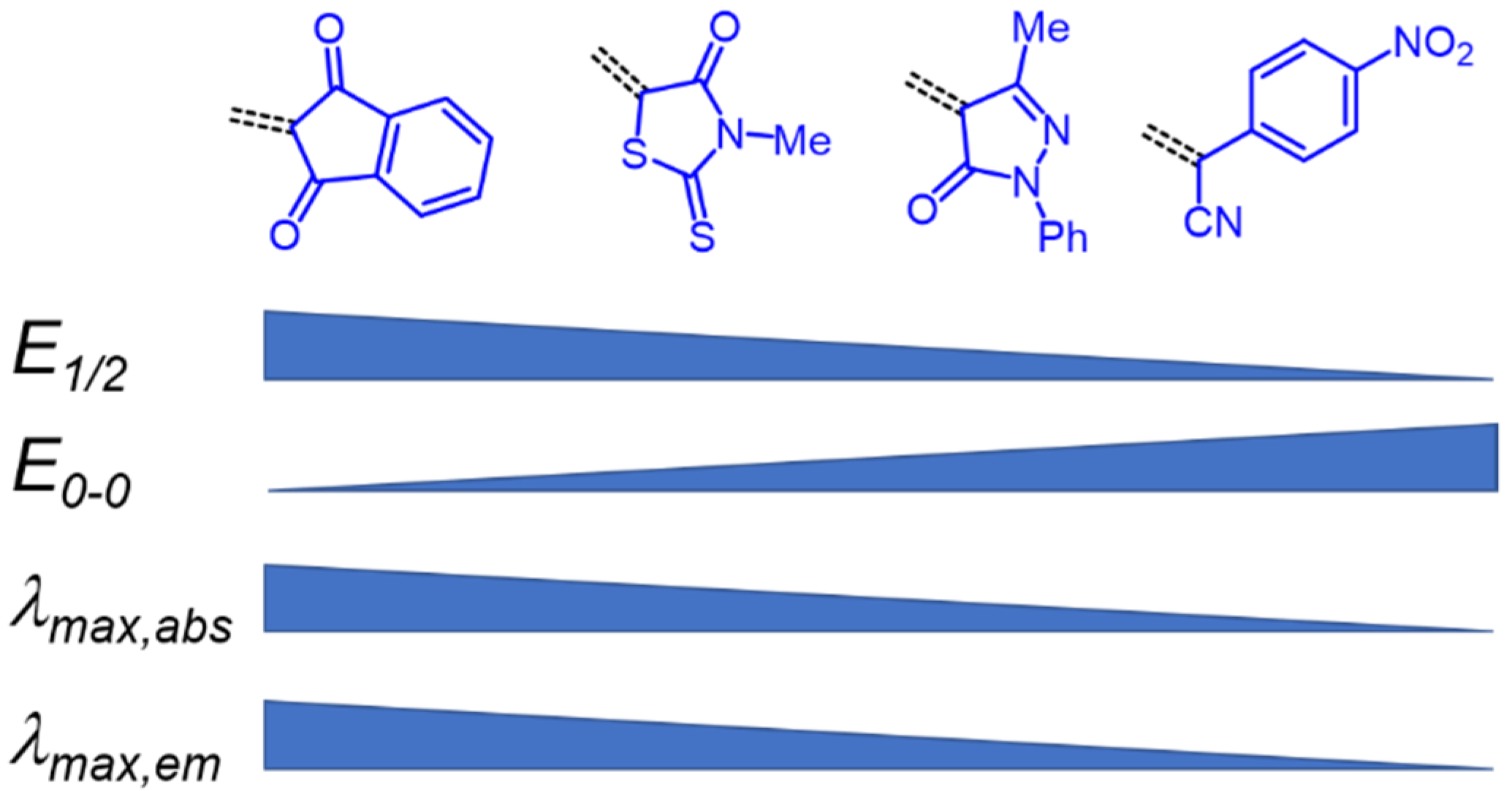
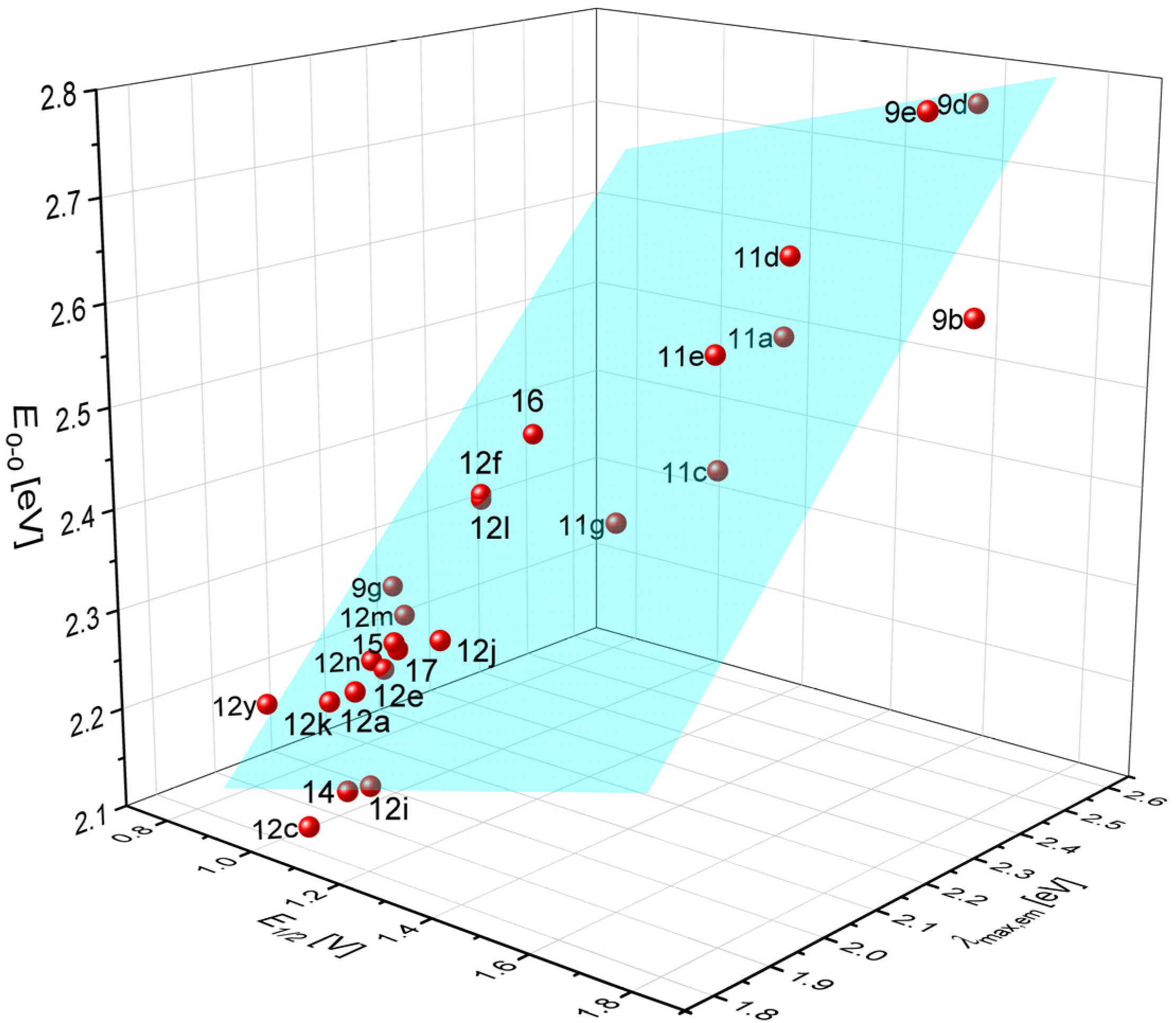
| Compound | E1/2 vs. NHE | λmax,abs | λmax,em | Stokes Shift ∆ṽ | E0-0 |
|---|---|---|---|---|---|
| [V] 1 | [nm] (ε [m−1cm−1]) | [nm] 2 | [cm−1] ([eV]) 3 | [eV] 4 | |
| 8a | >2.00 | 293 (18,000), 396 (42,000) | 451 | 3100 (0.382) | 2.943 |
| 8b | >2.00 | 261 (30,000), 302 (20,000), 384 (24,000), 438 (26,000) | 462 | 1200 (0.147) | 2.760 |
| 8c | >2.00 | 293 (14,000), 398 (44,000) | 470 | 3900 (0.478) | 2.879 |
| 8d | >2.00 | 294 (15,000), 364 (23,000) | 513 | 8000 (0.990) | 2.914 |
| 8e | 1.57 (irrev.) | 250 (25,000), 367 (35,000) | 412 | 3000 (0.369) | 3.197 |
| 8f | >2.00 | 296 (15,000), 402 (38,000) | 463 | 3300 (0.407) | 2.820 |
| 8g | 1.55 (irrev.) | 258 (22,000), 265 (21,000), 403 (38,000) | 486 | 4200 (0.526) | 2.866 |
| 8h | 0.95, 1.66 | 261 (30,000), 302 (20,000), 384 (24,000), 438 (26,000) | 555 | 4800 (0.597) | 2.535 |
| 8i | 0.93, 1.61 | 259 (35,000), 334 (20,000), 442 (15,000) | 561 | 4800 (0.596) | 2.510 |
| 9a | 1.60 (irrev.) | 289 (12,000), 313 (18,000), 451 (48,000) | 514 | 2700 (0.337) | 2.583 |
| 9b | 1.76 | 267 (23,000), 278 (14,000), 304 (8000), 450 (43,000) | 513 | 2700 (0.339) | 2.588 |
| 9c | >2.00 | 275 (13,000), 301 (4000), 434 (41,000) | 502 | 3100 (0.387) | 2.666 |
| 9d | 1.61 (irrev.) | 259 (25,000), 307 (5000), 421 (37,000) | 481 | 3000 (0.368) | 2.764 |
| 9e | 1.71 | 257 (43,000), 387 (54,000) | 525 | 6800 (0.843) | 2.785 |
| 9f | 1.13 (irr) | 305 (27,000), 352 (15,000), 499 (42,000) | 632 | 4200 (0.523) | 2.225 |
| 9g | 0.93, 1.61 | 256 (40,000), 304 (13,000), 379 (17,000), 490 (28,000) | 604 | 3900 (0.478) | 2.294 |
| 10a | 1.45 | 259 (21,000), 337 (9000), 462 (31,000) | – 5 | – 5 | – |
| 10b | 1.46 | 270 (13,000), 324 (21,000), 550 (26,000) | 650 | 2800 (0.347) | 2.083 |
| 10c | 1.38, 1.57 | 289 (22,000), 314 (22,000), 349 (25,000), 500 (50,000) | 594 | 3200 (0.393) | 2.286 |
| 10d | 0.87, 1.38 | 305 (27,000), 351 (23,000), 550 (40,000) | – 5 | – 5 | – |
| 10e | 0.87, 1.43 | 256 (28,000), 310 (21,000), 401 (6000), 556 (41,000) | – 5 | – 5 | – |
| 10f | 0.93, 1.46 | 262 (21,000), 313 (19,000), 347 (17,000), 419 (11,000), 523 (33,000) | – 5 | – 5 | – |
| 10g | 0.86, 1.40 | 274 (37,000), 310 (26,000), 345 (20,000), 420 (12,000), 527 (37000) | – 5 | – 5 | – |
| 10h | 0.86, 1.51 | 258 (51,000), 319 (20,000), 417 (11,000), 533 (30,000) | – 5 | – 5 | – |
| 11a | 1.44 | 253 (41,000), 262 (40,000), 298 (41,000), 354 (15,000), 453 (44,000) | 526 | 3100 (0.380) | 2.549 |
| 11b | 1.44 | 253 (34,000), 262 (35,000), 286 (35,000), 356 (13,000), 453 (39,000) | 530 | 3200 (0.398) | 2.541 |
| 11c | 1.46 | 253 (55,000), 285 (46,000), 347 (21,000), 464 (52,000) | 561 | 3700 (0.462) | 2.443 |
| 11d | 1.45 | 256 (44,000), 280 (40,000), 342 (22,000), 428 (29,000) | 526 | 4400 (0.540) | 2.629 |
| 11e | 1.44 | 260 (37,000), 284 (40,000), 344 (19,000), 431 (31,000) | 558 | 5200 (0.655) | 2.552 |
| 11f | 1.44 | 254 (40,000), 290 (32,000), 366 (13,000), 530 (45,000) | 628 | 2900 (0.365) | 2.159 |
| 11g | 1.34 | 281 (34,000), 303 (21,000), 352 (19,000), 467 (43,000) | 583 | 4300 (0.529) | 2.393 |
| 11h | 0.82, 1.38 | 252 (42,000), 307 (39,000), 329 (40,000), 425 (23,000) | – 5 | – 5 | – |
| 11i | 0.81, 1.39 | 286 (69,000), 341 (28,000), 424 (26,000) | – 5 | – 5 | – |
| 12a | 1.05, 1.68 | 271 (34,000), 302 (27,000), 361 (20,000), 482 (24,000) | 655 | 5500 (0.680) | 2.235 |
| 12b | 1.05, 1.68 | 271 (30,000), 303 (24,000), 358 (21,000), 483 (25,000) | 658 | 5500 (0.683) | 2.228 |
| 12c | 1.05, 1.69 | 268 (46,000), 309 (23,000), 338 (25,000), 512 (27,000) | 685 | 4900 (0.612) | 2.118 |
| 12e | 1.05, 1.70 | 260 (49,000), 311 (35,000), 487 (25,000) | 638 | 4900 (0.603) | 2.247 |
| 12f | 1.03, 1.69 | 271 (29,000), 319 (27,000), 472 (21,000) | 580 | 4000 (0.490) | 2.384 |
| 12g | 1.05, 1.69 | 267 (34,000), 320 (13,000), 392 (20,000), 410 (19,000), 580 (34,000) | – 5 | – 5 | – |
| 12h | – 6 | 280 (27,000), 307 (28,000), 358 (26,000), 473 (28,000) | 641 | 5500 (0.688) | 2.280 |
| 12i | 1.13 | 268 (35,000), 331 (29,000), 362 (21,000), 504 (28,000) | 668 | 4900 (0.605) | 2.160 |
| 12j | 1.17 | 277 (24,000), 304 (29,000), 358 (23,000), 472 (29,000) | 636 | 5500 (0.678) | 2.290 |
| 12k | 1.01 | 267 (32,000), 297 (25,000), 363 (21,000), 484 (25,000) | 660 | 5500 (0.684) | 2.222 |
| 12l | 1.03, 1.69 | 270 (29,000), 332 (25,000), 474 (21,000) | 580 | 4000 (0.478) | 2.379 |
| 12m | 1.00, 1.61 | 261 (45,000), 312 (27,000), 489 (21,000) | 614 | 4200 (0.517) | 2.280 |
| 12n | 1.03, 1.57 | 303 (29,000), 360 (23,000), 483 (23,000) | 640 | 5100 (0.630) | 2.254 |
| 12o | 0.79, 1.01 | 305 (23,000), 371 (49,000), 492 (28,000) | – 5 | – 5 | – |
| 12p | 1.06, 1.33 | 293 (18,000), 396 (42,000) | 651 | 5400 (0.674) | 2.243 |
| 12r | 0.98, 1.20 | 261 (30,000), 302 (20,000), 384 (24,000), 438 (26,000) | – 5 | – 5 | – |
| 12s | 0.86, 1.12 | 293 (14,000), 398 (44,000) | 629 | 4600 (0.565) | 2.255 |
| 12t | 0.86, 1.80 | 294 (15,000), 364 (23,000) | 634 | 4500 (0.560) | 2.237 |
| 12u | 0.86, 1.11 | 250 (25,000), 367 (35,000) | – 5 | – 5 | – |
| 12v | 0.85, 1.11, 1.67, 1.79 | 296 (15,000), 402 (38,000) | – 5 | – 5 | – |
| 12w | 0.85, 1.12 | 258 (22,000), 265 (21,000), 403 (38,000) | 658 | 5400 (0.667) | 2.220 |
| 12x | 0.86, 1.14, 1.47 | 261 (30,000), 302 (20,000), 384 (24,000), 438 (26,000) | 641 | 4700 (0.586) | 2.229 |
| 12y | 0.85, 1.17 | 259 (35,000), 334 (20,000), 442 (15,000) | 657 | 4900 (0.613) | 2.195 |
| 12z | 0.85, 1.11, 1.66, 1.81 | 289 (12,000), 313 (18,000), 451 (48,000) | – 5 | – 5 | – |
| 14 | 1.10 | 267 (23,000), 278 (14,000), 304 (8000), 450 (43,000) | 674 | 5000 (0.626) | 2.154 |
| 15 | 1.09 | 275 (13,000), 301 (4000), 434 (41,000) | 642 | 5700 (0.696) | 2.281 |
| 16 | 1.08, 1.76 | 259 (25,000), 307 (5000), 421 (37,000) | 565 | 3900 (0.490) | 2.441 |
| 17 | 1.09 | 257 (43,000), 387 (54,000) | 640 | 5400 (0.668) | 2.273 |
| Donor |  | |||||
|---|---|---|---|---|---|---|
| Acceptor | E1/2 [V] | λmax,abs [eV] | λmax,em [eV] | Δṽ [eV] | E0-0 [eV] | |
 | 9a | 1.66 | 2.752 | 2.414 | 0.337 | 2.583 |
| 11a | 1.44 | 2.740 | 2.359 | 0.380 | 2.549 | |
| 12a | 1.05 | 2.575 | 1.895 | 0.680 | 2.235 | |
| 15 | 1.09 | 2.629 | 1.933 | 0.696 | 2.281 | |
 | 9b | 1.76 | 2.758 | 2.419 | 0.339 | 2.588 |
| 11c | 1.46 | 2.675 | 2.212 | 0.462 | 2.443 | |
| 12c | 1.05 | 2.424 | 1.812 | 0.612 | 2.118 | |
| 14 | 1.10 | 2.467 | 1.841 | 0.626 | 2.154 | |
 | 9d | 1.61 | 2.948 | 2.580 | 0.368 | 2.764 |
| 11d | 1.45 | 2.899 | 2.359 | 0.540 | 2.629 | |
| 12e | 1.05 | 2.548 | 1.945 | 0.603 | 2.246 | |
| 17 | 1.09 | 2.607 | 1.939 | 0.668 | 2.273 | |
 | 9e | 1.71 | 3.207 | 2.364 | 0.843 | 2.785 |
| 11e | 1.44 | 2.879 | 2.224 | 0.655 | 2.552 | |
| 12f | 1.03 | 2.629 | 2.140 | 0.490 | 2.384 | |
| 16 | 1.08 | 2.686 | 2.196 | 0.489 | 2.441 | |
| Acceptor | Linear Correlation Equations E0-0 vs. E1/2 | Correlation Coefficient |
|---|---|---|
 | E0-0 = 1.41368 + 0.67953·E1/2 [eV] | r2 = 0.98716 |
 | E0-0 = 1.25336 + 0.94225·E1/2 [eV] | r2 = 0.99896 |
 | E0-0 = 1.62924 + 0.59758·E1/2 [eV] | r2 = 0.94309 |
 | E0-0 = 1.83274 + 0.53835·E1/2 [eV] | r2 = 0.94765 |
Publisher’s Note: MDPI stays neutral with regard to jurisdictional claims in published maps and institutional affiliations. |
© 2021 by the authors. Licensee MDPI, Basel, Switzerland. This article is an open access article distributed under the terms and conditions of the Creative Commons Attribution (CC BY) license (https://creativecommons.org/licenses/by/4.0/).
Share and Cite
Meyer, T.; Krug, R.; Müller, T.J.J. Three-Component Suzuki–Knoevenagel Synthesis of Merocyanine Libraries and Correlation Analyses of Their Oxidation Potentials and Optical Band Gaps. Molecules 2021, 26, 5149. https://doi.org/10.3390/molecules26175149
Meyer T, Krug R, Müller TJJ. Three-Component Suzuki–Knoevenagel Synthesis of Merocyanine Libraries and Correlation Analyses of Their Oxidation Potentials and Optical Band Gaps. Molecules. 2021; 26(17):5149. https://doi.org/10.3390/molecules26175149
Chicago/Turabian StyleMeyer, Tim, Roxanne Krug, and Thomas J. J. Müller. 2021. "Three-Component Suzuki–Knoevenagel Synthesis of Merocyanine Libraries and Correlation Analyses of Their Oxidation Potentials and Optical Band Gaps" Molecules 26, no. 17: 5149. https://doi.org/10.3390/molecules26175149
APA StyleMeyer, T., Krug, R., & Müller, T. J. J. (2021). Three-Component Suzuki–Knoevenagel Synthesis of Merocyanine Libraries and Correlation Analyses of Their Oxidation Potentials and Optical Band Gaps. Molecules, 26(17), 5149. https://doi.org/10.3390/molecules26175149






